In our previous diversity studies on the Academy Awards, the Emmy Awards, the children’s book field, The New York Times Top 10 Bestseller List, Sci-Fi and Fantasy Films, the Tony Awards, and Silicon Valley we interviewed people who actively work in television, publishing, and the theater. We attempted to duplicate this approach for our diversity study on US politics, but with the government shutdown, none of the twelve Congresspeople we contacted responded to our efforts to reach out to them. However, we think the numbers speak for themselves:
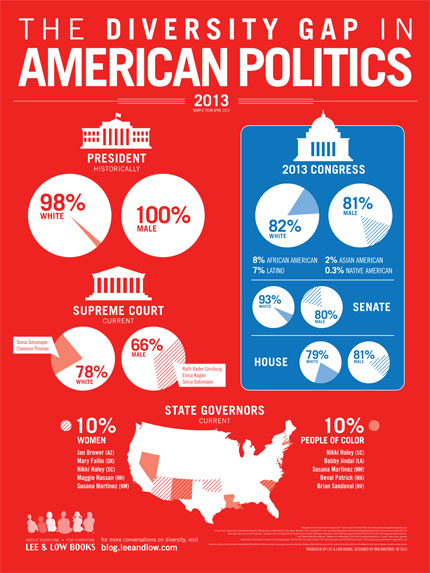
So we have applied a different approach for this study. We have identified five main obstacles standing between the diverse US population and a government that is more representative of the actual population. If you can think of other reasons, please leave them in the comments section below.
1. Gerrymandering
We live in an era in which both political parties are becoming more extreme and states are becoming more and more polarized. In the House of Representatives, gerrymandering, the process of dividing an area into districts to give one political party an electoral advantage over the other, is partly to blame. Both parties have played around with district borders countless times, producing polarized voter blocks.
“We are a complex country,” says Rob Richie, executive director of FairVote.org, but the current system creates “a funhouse mirror distortion of who we are that channels us into two narrow, doctrinaire groupings.”
{Read full article}
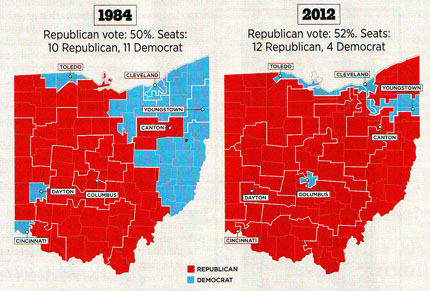
“Lawmakers no longer need to appeal to the political ‘middle’ to try to win general elections, but must instead deliver only to their own party’s true believers,” writes Luisa Ch. Savage in Maclean’s, a Canadian current affairs magazine.
However, many political experts say that the polarization goes much deeper. Gerrymandering doesn’t affect Senators (you can’t redraw state lines), but the Senate is just as polarized as the House. This points to increasing polarization of states. “There used to be a great many states that were very competitive in national elections. In 1976, almost half the states in the union came within 3 points of the nationwide vote in the presidential election. A more impressive 30-plus states were within 5pt. Today, the numbers aren’t even close to that,” writes Harry J. Enten in The Guardian.
{Read full article}
What that means on a practical level is that people who believe different things don’t live or work together.
{Read full article}
2. Voter ID Laws
Voter ID laws, which have been passed in more than thirty states, are laws intended to prevent voter fraud by making sure each voter is who he or she says he or she is. The laws do this by requiring special forms of ID, which vary state to state. Some states require only a current utility bill or bank statement while the strictest states require a government-issued photo ID.
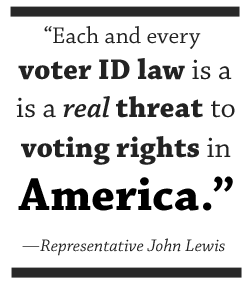
People who are against strict voter ID laws argue that the laws disproportionately affect elderly, minority, and low-income groups. Obtaining a photo ID can be costly and difficult, especially for those with limited mobility or inflexible work hours. As legal scholars Bruce Ackerman and Jennifer Nou explain, “Texans without IDs must travel as much as a hundred miles to a driver’s license office and submit appropriate documents, along with their fingerprints, to establish their qualifications. If they don’t have the required papers, they must pay $22 for a copy of their birth certificate. If they can’t come up with the money, they can’t vote.” As a result, the photo ID laws create a new “financial barrier to the ballot box.” {Read full article}
According to New York University’s Brennan Center for Justice, about 11% of US citizens (roughly 21 million) do not have government-issued photo IDs. In a close election, that could certainly be enough to change the outcome, even if all of those people were not regular voters.
{Read full article}
Among minorities, the percentages are even higher. According to the NAACP, 25% of African Americans and 16% of Latinos of voting age lack a current government-issued photo ID.
{Read full article}
According to Representative John Lewis, “Each and every voter ID law is a real threat to voting rights in America. Make no mistake, these voter ID laws are a poll tax. I know what I saw during the 60s. I saw poll tax.”
{Read full article}

3. Voter Turnout
The United States has one of the lowest voter turnout rates among democratic countries. The right to vote should not be taken for granted. Not so long ago, women and minorities in the US could not vote. A person cannot complain about the way things are if he or she does not bother to vote.
According to the United States Election Project at George Mason University, the 2012 election had a 58.2% turnout rate among the voting eligible population.
{Read full article}
According to FairVote.org, “Even at its highest level in 1960, the percent of eligible Americans who turned out to vote never surpassed 65%. This is still substantially lower than in almost all established democracies; turnout is 70-75% in Canada and well over 80% in most other democracies, including 86.8% in the first round of the French presidential election and 91.7% in the 2004 proportional representation election for Luxembourg’s legislature.”
There is also an enormous disparity in the United States across income levels in voting participation. “A study on these disparities found that 86% of people with incomes above $75,000 claim to have voted in presidential elections as compared with only 52% of people with incomes under $15,000. As a result of the participation disparity across demographic lines, politicians are more responsive to the opinions of high-income constituents.”
Some people point to certain barriers to voting such as registration, voter ID laws, and the scheduling of elections during the workweek as reasons for the low turnout among low-income voters. However, Fairvote.org asserts that the biggest factor in voter participation is probably voter motivation and the perception that votes will or will not make a difference.
{Read full article}
4. Campaign Finance Rules
In 2010 the Supreme Court ruled on a case called Citizens United vs. Federal Election Commission. In that ruling, the Court said that the First Amendment, which guarantees free speech, prohibits the government from restricting political independent expenditures by corporations, associations, or labor unions. Among other things, this meant that big corporations were allowed to spend unlimited funds to lobby for a particular candidate, often through third-party independent groups called super PACs.
Before the Supreme Court’s ruling in 2010, the law governed corporate election spending under the assumption that “corporations had so much money that their spending would create vast inequalities in speech that would undermine democracy,” according to the libertarian Cato Institute.
{Read full article}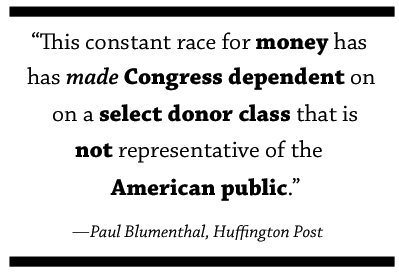
Since the Citizens United decision, corporate spending for elections has gone up exponentially. According to a Slate magazine article by Richard L. Hasen, total outside spending as of March 2012 was up 234% from 2008’s numbers and 628% from 2004’s. Political experts disagree on how much of the increase was caused by the court decision, but, as Hasen says, “If this was not caused by Citizens United, we have a mighty big coincidence on our hands.”
{Read full article}
“This constant race for money has made Congress dependent on a select donor class that is not representative of the American public,” writes Paul Blumenthal for the Huffington Post. He points to several recent political science studies that found that Congress is “most responsive to the concerns of the wealthy, while hardly registering the opinions of lower-income Americans.”
If the rich use their money to speak, it goes hand-in-hand that those without money (including many people of color, who make up a disproportionate percentage of low-income Americans) are left without a voice.
{Read full article}
5. Racism and Sexism
Women and people of color in politics face both overt and subtle prejudice when campaigning and attempting to do their jobs. Much has been written about the ways in which President Obama has been treated because of his race. For example, although President Clinton also faced strong opposition, “no one called Clinton a ‘food stamp president’ or attacked his health care plan as ‘reparations.’ Local lawmakers didn’t circulate racist jokes about the former Arkansas governor, and right-wing provocateurs didn’t accuse Clinton of fomenting an anti-white race war,” writes Jamelle Bouie in The American Prospect, pulling from a long article by Ta-Nehisi Coates in The Atlantic.
{Read full article}
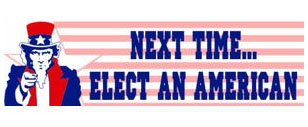
Women also face below-the-belt sexist criticism that undercuts their standing as candidates and politicians. A 2010 study reported in USA Today said that “calling a female candidate such sexist names as ‘ice queen’ and ‘mean girl’ significantly undercuts her political standing . . . doing more harm than gender-neutral criticism based solely on her policy positions and actions.”
{Read full article}
Lean In’s Sheryl Sandberg points out that “women are perceived as too soft or too tough but never just right, and as competent or likeable, but rarely both.” {Read full article}
Inequality in the representation of women and people of color is an entrenched societal problem. The million dollar question is: Do US leaders and citizens have the will to make the necessary changes to fix government and make it an apparatus that works for all people and not just a chosen few?
***
This is not an isolated incident, but a wide reaching societal problem.
Read more Diversity Gap studies on:
The Tony Awards
The Emmy Awards
The children’s book industry
The New York Times Top 10 Bestseller List
The Academy Awards
Sci-Fi and Fantasy Films
Silicon Valley
Further resources on how to teach content and visual literacy using Lee & Low Books’ infographics series on the Diversity Gap:
Using Infographics In The Classroom To Teach Visual Literacy


Reblogged this on Smart by Choice Blog and commented:
The following quote by Ms. Horning is why ethnic diverse authors are needed in today’s marketing whether the purpose is to go mainstream publishing or independent self-publishing.
Kathleen T. Horning, Director of Cooperative Children’s Book Center (CCBC), School of Education, University of Wisconsin-Madison: “…I’ve heard many times from publishers that the “buyers at B&N” believe multicultural books don’t sell. When they are not stocked in these bookstores, it becomes a self-fulfilling prophecy.”
Even if you do not believe you are ready to get your work published, contact me and let’s set up a time to review your goals for your work. Email me at onesmartlady50@gmail.com or call (888)412-9279. Let’s raise the bar in multicultural product availability for all ages.
The next major election will take place on Tuesday, Nov. 5, 2013. There are no races for members of Congress this year, but there are several races taking place across the country on the state or local level. There are two elections for governor, in New Jersey and Virginia, along with several mayoral elections. To find out if your area will be holding an election, if you’re registered, and who will appear on your ballot, visithttp://www.vote411.org/
I am genuinely glad to glance at this blog posts which includes plenty of helpful
facts, thanks for providing such data.